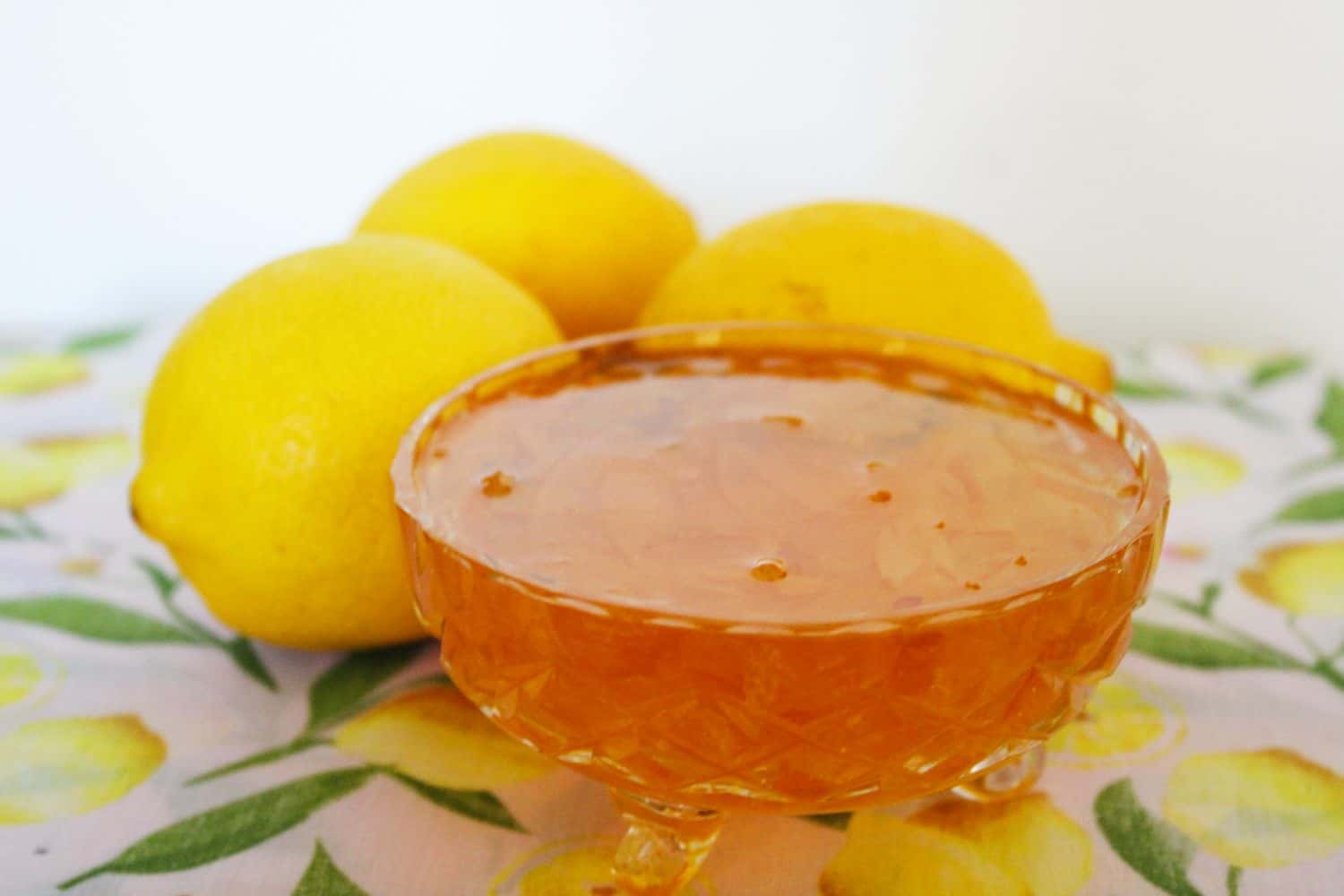
Lemon Marmalade has always been a favourite with my parents, my father in particular. He has been without his homemade breakfast condiment for a few weeks now and has politely let us know that a jar of shop-bought marmalade is not on his agenda.
As fortune would have it, a friend presented me with some beautiful, homegrown lemons and I have set to work. This is a classic method of making marmalade. It requires just three ingredients, and one of them is water. That is all that you need to make this fresh-flavoured condiment.
If you think that making marmalade is difficult, I want to assure you that it is easier than you may think. Although there is a great deal of science involved, it just requires that you follow a few simple steps.
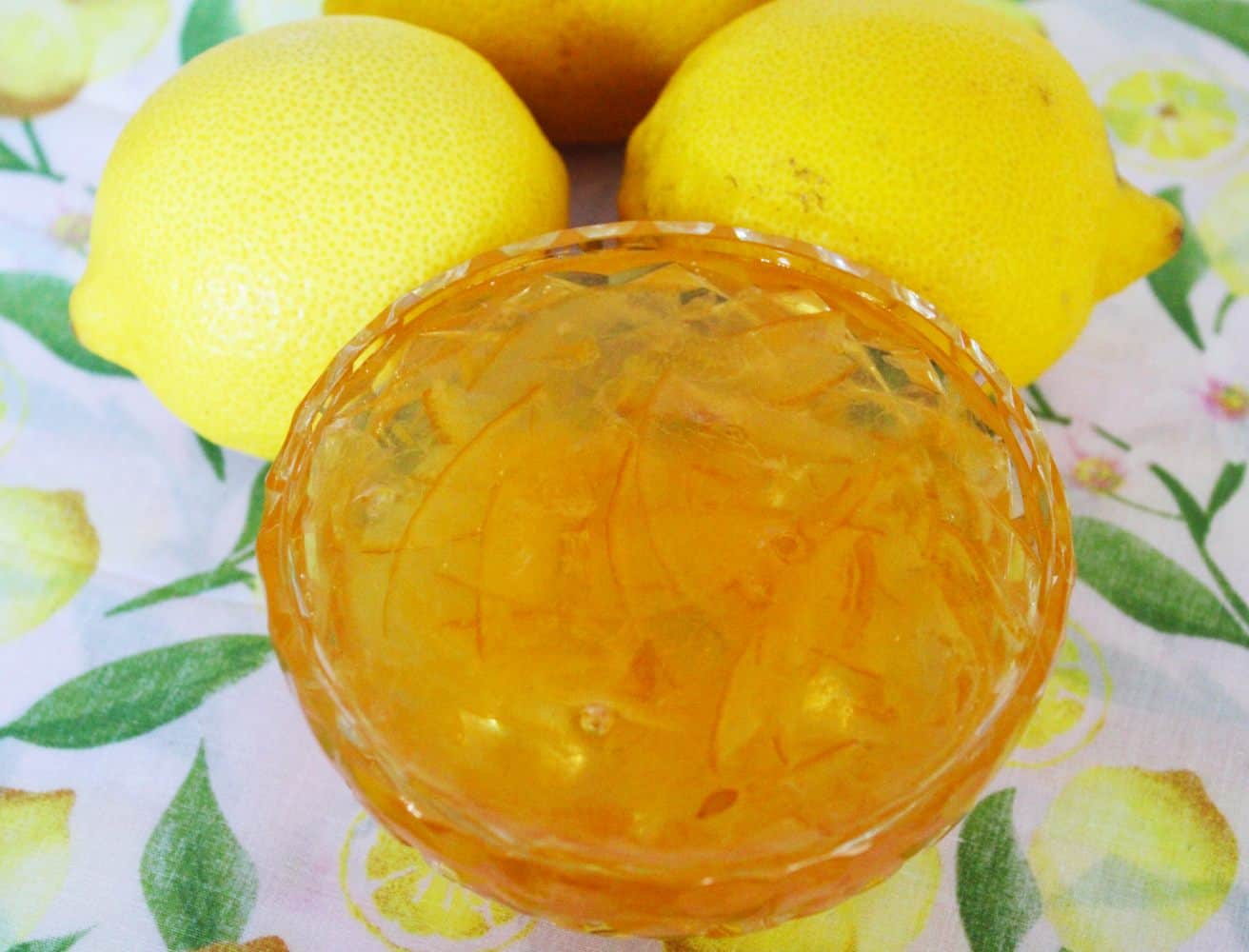
Let me tell you a little about Marmalade:
Marmalade is a favoured preserve on many breakfast tables. It’s easy to appreciate that this zesty, tangy preserve is a great way to start the day.
Marmalade is only made from citrus fruits, unlike jam, which can be made from any variety of fruit. Moreover, citrus fruits are rich in naturally occurring pectin. High amounts of pectin and acid, such as in citrus, help the marmalade to set, making it ideal for preserving. As such, it is not necessary to buy special jam-setting sugar.
I regard homemade jams and spreads as luxury items. It’s not that they are expensive to make, especially when the fruit is a gift, but there is an investment of time. However, having jars of marmalade that you have made yourself is tremendously satisfying.
The flavours are bright and clear and remember, there are just three ingredients. Compare that with the labels of some commercial varieties which often have a large range of additives.
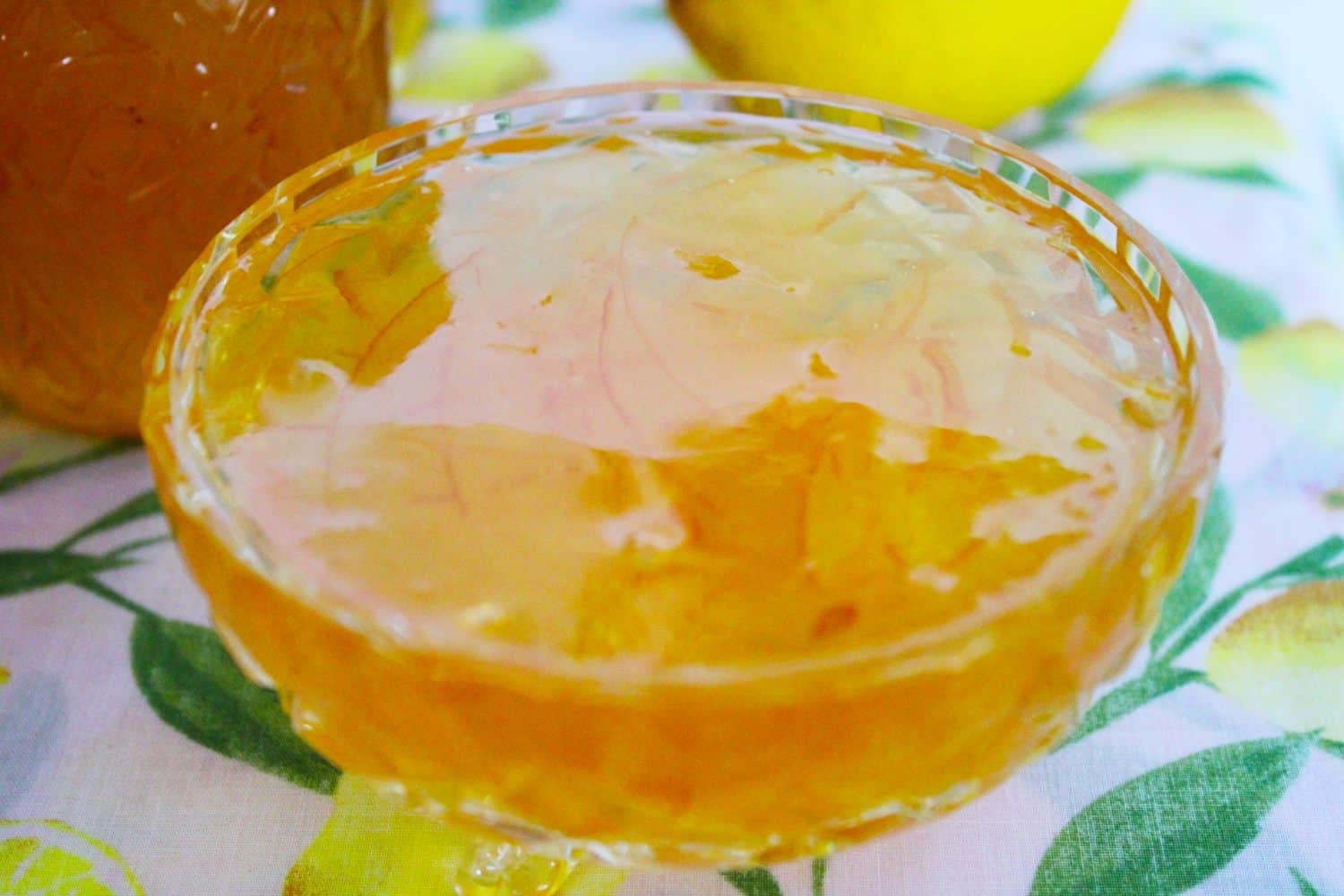
Ingredients in my Three Ingredient Lemon Marmalade:
Lemons:
Given that we will be using the entire fruit, it is preferable to use home-grown or organic lemons. Commercially produced lemons generally have a wax coating and may have been sprayed.
Sugar:
I use regular, granulated sugar. It is a large amount of sugar but it does much more than sweeten the marmalade. Its main function is to combine with the pectin and fruit acids to form a gel. In addition, it acts as a preservative that inhibits the growth of mould.
I don’t recommend reducing the amount of sugar as it may interfere with the setting and preservation.
Water:
I have used filtered water but regular tap water is also fine.
How to make Three Ingredient Lemon Marmalade:
Making the marmalade is a two-day process. On the first day, you slice the lemons very finely and put them into a large bowl with water to soak overnight. Soaking the fruit serves two purposes.
Firstly, it softens the peel and secondly, it helps release the pectin required for setting the jam. On day two you cook the fruit and add the sugar.
When setting point is reached, as outlined in the recipe instructions, I remove the saucepan from the heat and set it aside for 10 minutes. This will help the fruit to settle and evenly distribute when poured into the jars.
Without settling, the fruit will rise to the top of the marmalade. And finally, ladle it into jars and smile with satisfaction at the result.
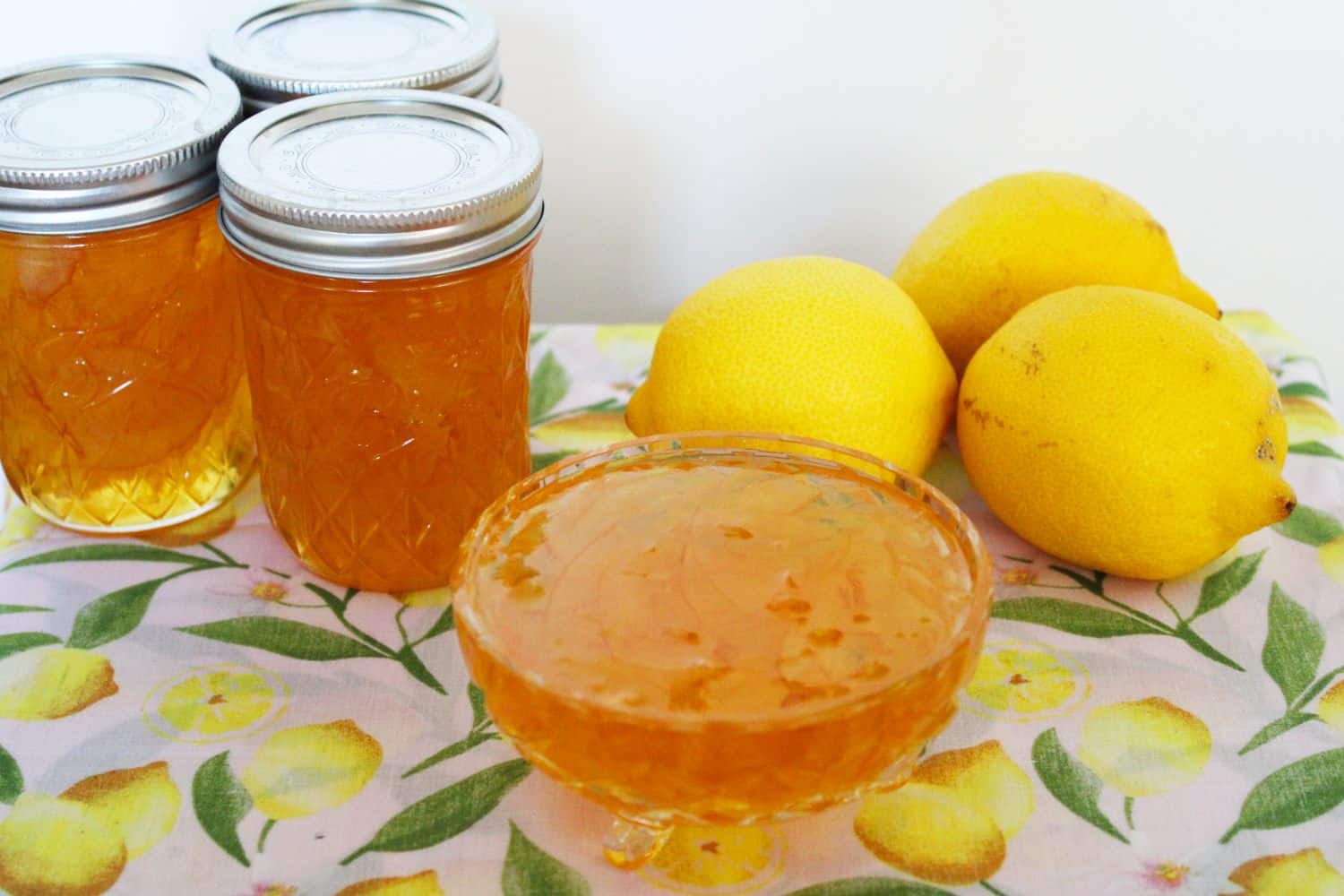
Tips for success:
You will not need any special equipment to make this recipe. However, a large saucepan is essential. When you add the sugar, it foams up enormously. Without a very large saucepan, there is the risk of it boiling over.
Your jars and their lids must be sterilised. I do this by heating them in the oven as outlined in the recipe.
As we are using the whole fruit, it is best to use organic or home-grown fruit. However, if you are only able to access commercially grown lemons, they need to be thoroughly cleaned.
Always use fruit which is in good condition and ideally some which are slightly under-ripe as they will contain more pectin. Bruised or damaged fruit may spoil the jam, causing it to deteriorate quickly.
It is important to cook the peel until it is tender before you add the sugar. Once you add the sugar the peel will no longer soften. After adding the sugar it is necessary to completely dissolve it before bringing the mixture back to the boil.
I find it best to check for setting point by checking a small amount of marmalade on a chilled plate. I use the “wrinkle” test, as detailed in the recipe. After reaching setting point, set the marmalade aside for 10 minutes to allow the fruit to settle.
Ladle the marmalade into hot jars to avoid the glass breaking.
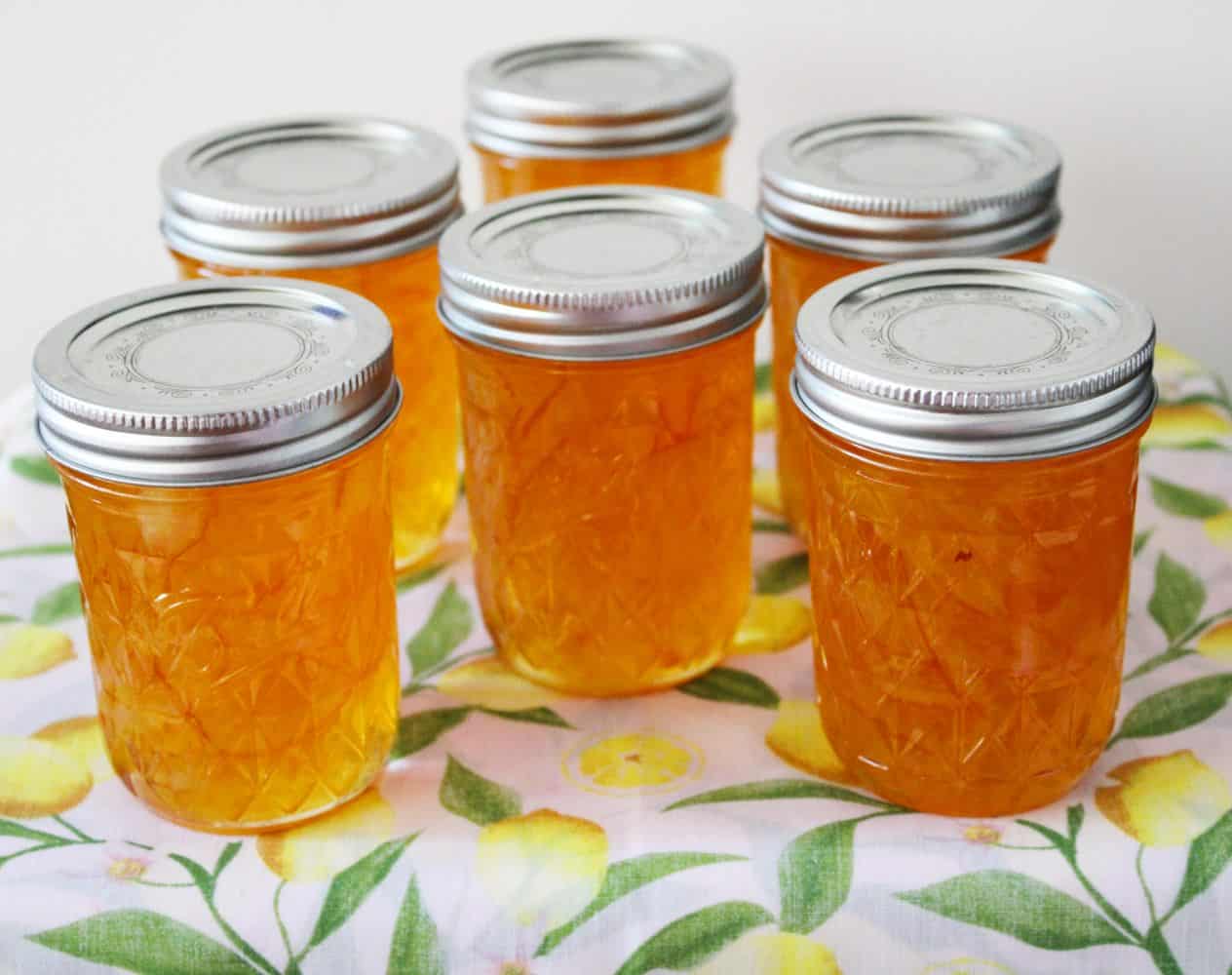
Other uses for these ingredients:
We love lemons, and some of our other favourite ways to use them are:
- Individual Lemon Curd Meringues
- Classic Lemon Curd
- Gluten-Free Lemon Madeleines
- Belgian Lemon Tea Cake
- Quick and Easy Lemon Ice Cream
More delicious condiments and edible gift ideas:
- Apricot Jam
- Fresh Peach Chutney
- Easy Plum Jam
- Classic Lemon Curd
- Dill Pickled Cucumbers
- Sweet Chilli Sauce
- Balsamic Glaze
- Preserved Chillies in Oil
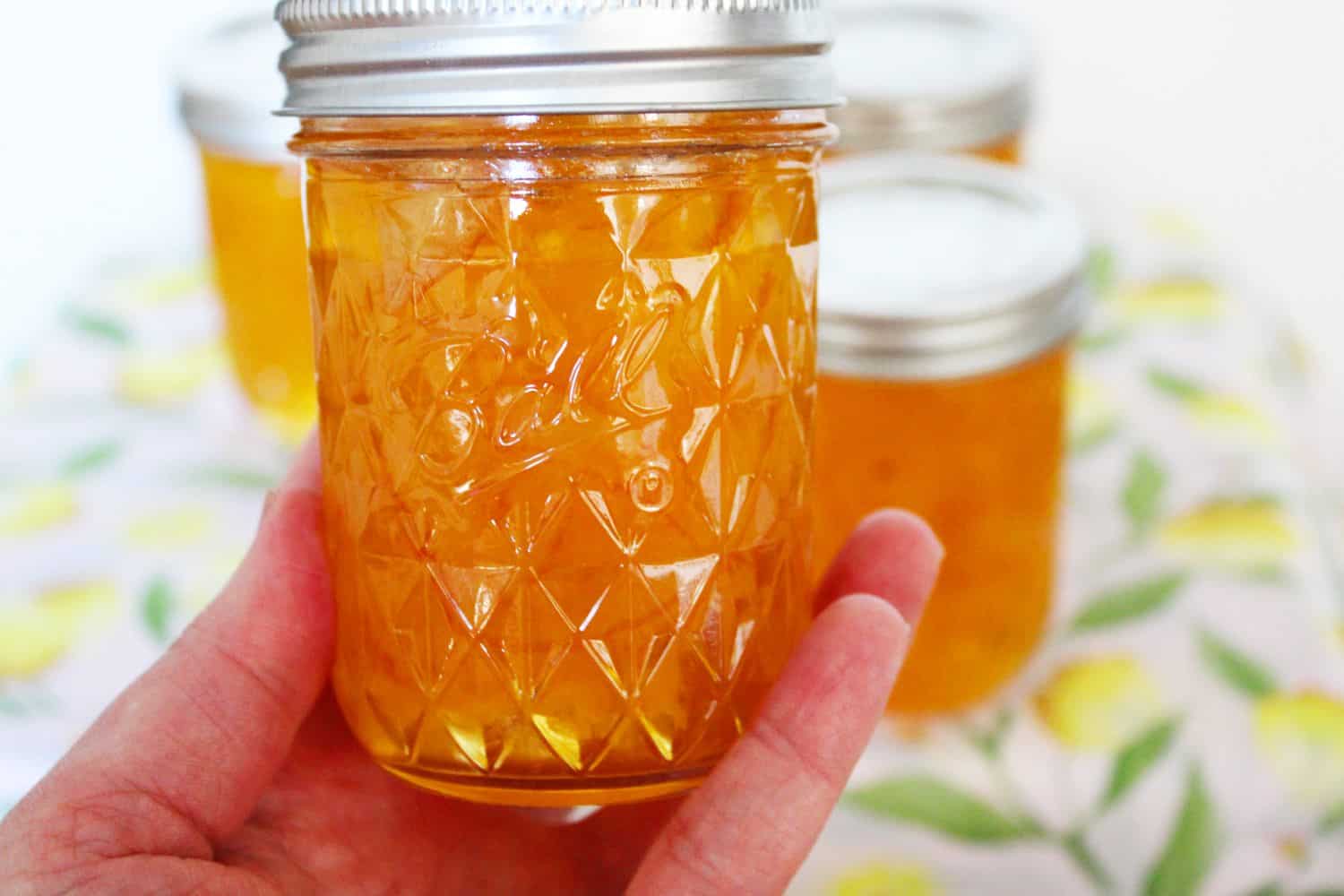
When it comes to using the Lemon Marmalade:
First and foremost, this bright and zesty condiment with the zingy flavour of lemon is a great wake-up call, perfect when slathered on your morning toast.
However, there are other ways in which to use it:
- A sticky glaze for chicken drumsticks;
- Make a sauce for pork tenderloin;
- Glaze a Christmas ham;
- Make crostini with goat cheese and prosciutto;
- Bake a lemon cake and make a glaze with the marmalade;
- Serve with Coconut Scones by A Baking Journey.
This refreshing condiment highlights the bright, tangy flavours of lemon. Although it is an ideal toast topping there are other ways in which to enjoy this condiment.
When you try it you will realise that there is no comparison between homemade marmalade and the commercially produced varieties.
Do let me know in the comments below when you have tried this delicious recipe.
Alex xx
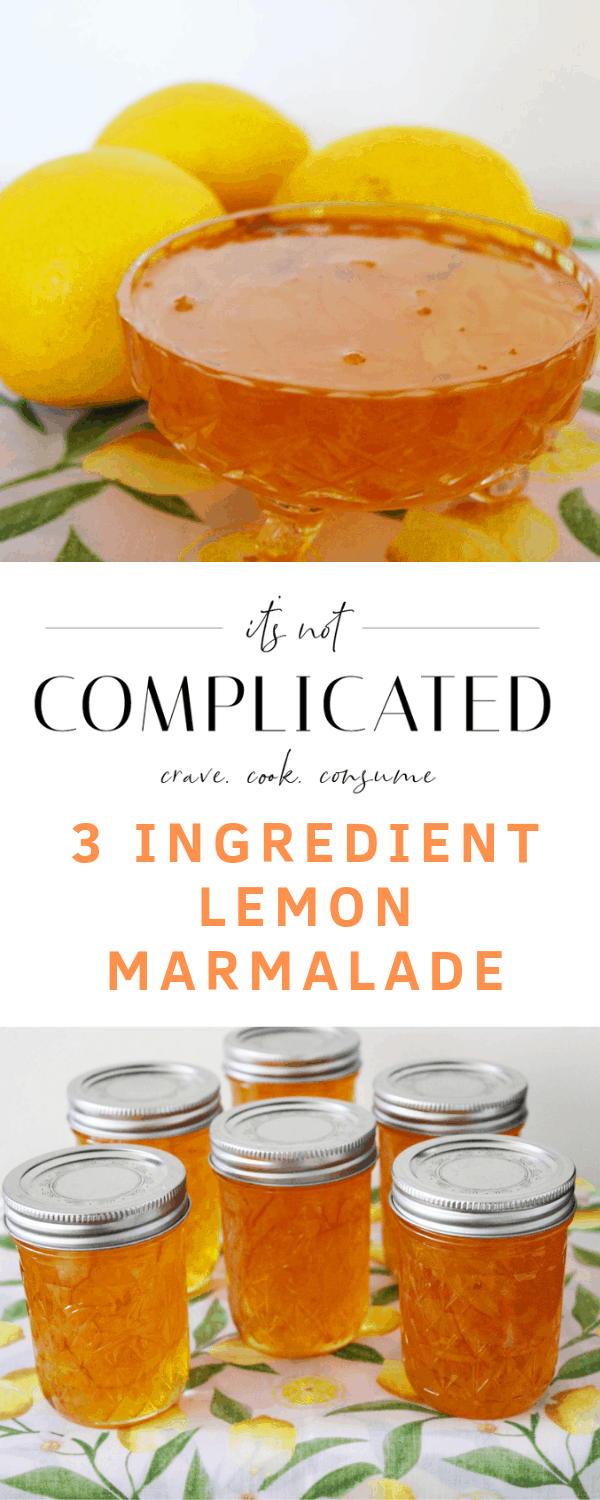
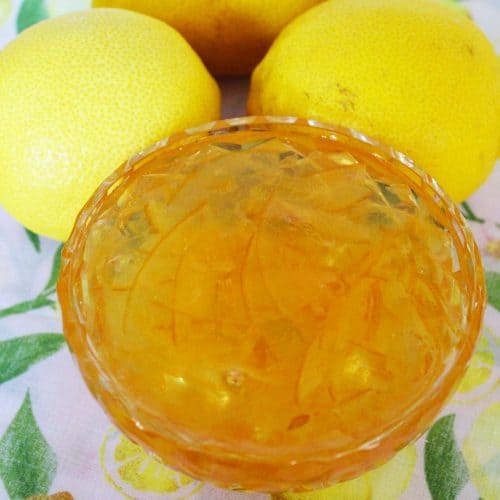
Three Ingredient Lemon Marmalade
Equipment
- 9 x 250ml Jars
Please note:
For accuracy, when weights are provided, we recommend weighing your ingredients. This will produce the best results. All oven temperatures listed are for fan forced.
Ingredients
- 500 g (17.5 ounces) lemons See Notes 1 & 2
- 6 cups (1.5 litre) water
- 8 cups (1.8kg) sugar
Instructions
Please Read First:
- Preserve making is quite simple, but we do recommend reading the recipe through first and following these tips:– weigh your ingredients for accuracy.– do not double the recipe or alter the quantities.– yes, it’s a lot of sugar. It’s also a lot of water. When making marmalade, the sugar is not just a sweetener, it also assists with gelling and preservation. When prepared properly, your end result will be the perfect mix of sweet, citrus tang and bitter, as marmalade should be. This is an old-fashioned recipe (my great great grandmothers.) – use a very large saucepan as the marmalade needs to rapidly boil and will foam up and you don’t want it to overflow.– ensure the marmalade reaches setting point. Keep in mind the marmalade will be very liquid while hot. Do not over boil as you will risk burning the marmalade.– allow 24-48 hours once jarred for the pectin to activate and the marmalade to set properly.– if after this time your marmalade hasn’t set, it likely wasn’t cooked for long enough initially. In this case, add the marmalade back to a clean saucepan with the juice of a fresh lemon. Bring back to the boil and start testing after 5 minutes of rapid boiling.
To sterilise the jars:
- Preheat the oven to 130 Degrees C (270F).Use glass jars with an airtight, metal lid. Wash them either in the dishwasher or by hand in hot soapy water, and rinse well. Check that the metal lids do not have rubber inserts. If they do, allow them to air dry.(See Note 9)
- Place upright jars and lids on a baking tray. Heat in the oven for at least 20 minutes, then remove and immediately fill with marmalade.
For the Lemon Marmalade:
- Place 2 saucers or small plates in the freezer, ready to check for the setting point of your marmalade.
- Thoroughly wash the lemons. Remove each end of the lemons and cut the lemons into quarters lengthways. Holding two of the quarters together, slice as thinly as possible and remove any seeds.
- Place the lemon slices in a non-reactive bowl. See Note 3. Add 6 cups of water, cover the bowl and leave the lemons to stand overnight.
- The following day, place the lemons and water into a large, non-reactive saucepan. – See Note 4.
- Over medium-high heat, bring the fruit and water to the boil. Boil for approximately 15 minutes or until the lemon peel is tender, stirring occasionally with a long-handled wooden spoon. – See Note 5. The time may vary slightly depending on the variety of lemon and the thickness of the slices.
- Add the sugar and stir well to dissolve it. After dissolving the sugar, return the fruit to the boil, stir occasionally and skim to remove any foam. Continue to stir until the marmalade reaches setting point, about 20 minutes. – See Note 6Remove from the heat to conduct the wrinkle test. If not set, continue to boil for another 1 minute and then test again.
- To test for setting point, I use the “wrinkle” test. Take one of your saucers from the freezer and pour a small amount of marmalade onto it. Let it cool for a minute then push against the marmalade with the tip of your finger. If the surface wrinkles it means setting point has been reached. Alternatively, if you are not confident checking this way or are not experienced at making marmalade, you can use the fail-safe method of using a jam/candy thermometer which you clip to the side of your saucepan. When attaching your thermometer, make sure that the base is not touching the bottom of the saucepan. Your marmalade has reached setting point when the temperature reaches 104.5 degree C or 220 degrees F. It will still be liquid at this point, and will set as it cools.
- Take the mixture off the heat and let the marmalade stand for about 10 minutes. This will help evenly distribute the fruit throughout the jars.
- Remove your jars from the oven and carefully ladle the marmalade into the heated, sterilised jars. You need to be very careful. Splashing yourself with hot marmalade will result in a very serious burn. I suggest you have clothing with long sleeves and ensure that you do not have children nearby. Put lids on jars immediately, and seal well – being careful to use a cloth or oven gloves to handle the jars/lids.
Video
Notes
- The weight of the lemons, before trimming the ends and removing the seeds, was 530 gm/1.2 lbs. We use Eureka or Lisbon lemons for this recipe.
- As the peel is such an important part of the marmalade, I like to use organic or home-grown lemons. Commercially produced lemons generally have a wax coating and may have been sprayed. If this is all that you can obtain, you can clean the lemons by placing them in a colander and pouring over freshly boiled water. Then, scrub them gently with a nail brush while holding them under cold running water.
- Non-reactive bowls and saucepans are stainless steel, glass, ceramic or enamelled cookware. Aluminium, copper and iron bowls or pans are reactive. Acidic foods, such as lemons, may discolour and take on a metallic taste if these are used.
- A large saucepan is essential. When you add the sugar, it foams up enormously. Without a very large saucepan, there is the risk of it boiling over.
- To stir, use a long-handled wooden spoon. Metal will become dangerously hot.
- Boiling time depends on several factors, the width of your saucepan and the heat at which the fruit is boiled.
- The Marmalade will be shelf stable for approximately 12 months.
- Your marmalade will be very liquid when you add it to the jars so please don’t be concerned. It will continue to thicken as it cools. Leave it for 24-48 hours and then check again. If it is still runny, you can re-boil the marmalade. Empty the contents of the jars back into the saucepan and bring to a boil. To increase the pectin and help the marmalade to set, you can add the juice of half a lemon. Boil for a few minutes and test again.However, if the marmalade was initially boiled too long, it can still result in it not setting as the pectin may have been damaged.
- Properly sterilising your jars is an essential process to remove bacteria which could cause your preserves to spoil. I prefer to sterilise jars in the oven. To do this, preheat your oven to 130 Degrees C (270F). Use glass jars with an airtight, metal lid. If recycling jars, ensure that the jars do not have cracks or chips and the lids are in good condition. Discard any lids that are pitted or rusted. Wash the jars and lids either in the dishwasher or by hand in hot soapy water, and rinse well. Do not dry them with a tea towel. Place upright jars and lids on a baking tray. If you are using kilner jars with rubber seals, be sure to remove the seals before placing the jars in the oven. The dry heat of the oven would damage the seals. Boil the seals separately in a saucepan for about 10 minutes. Heat the jars in the oven for at least 20 minutes. When your preserves are ready to bottle, use thick oven mits or jar tongs to remove the jars. Do not place them on a cold surface as they may shatter. I place mine on a wooden chopping board which I cover with a tea towel. Always sterilise a few more jars than you think you will need. It is better to have too many jars than not enough.
- Please note, the nutritional information is based on one 250ml jar. Please take this into account, as you most likely won’t be consuming a whole jar in one sitting. The nutritional information is an estimate only.
Nutrition Estimate:
Nutritional Disclaimer:
The nutritional information is an estimate only, and is derived from online calculators. For accurate results, we recommend calculating the nutritional information based on the ingredients and brands you use.

David Smith
Hi Alex, thanks for recipe which I look forward to using, but am wondering if you can use frozen lemons and if so, should I defrost them first and then follow the recipe.
I think slicing them frozen might be difficult and dangerous.
Alexandra Cook
Hello David,
Thank you for your question!
I personally have not made marmalade with frozen lemons before, but I would think it would work fine if they were frozen in optimum condition.
Yes, you’d definitely want to let them defrost slightly so they are safer to cut.
A few things I’d keep in mind:
– The fruit will almost definitely take less time to cook before you add the sugar as they’ll already be soft, so just keep an eye on this.
– I’d keep a few fresh lemons on hand if you’re having trouble reaching the setting point. You can add just the lemon juice to boost the pectin if needed. (This may not be necessary.)
I hope that helps, and do let me know if you give it a try 🙂 Alex xo
Nadine
I’ve used your recipe and made the most marvelous marmalade. I also made lime cordial using purchased lime juice. I felt that a whole 250g of sugar was a lot so I added about 3/4 cup of lemon juice to the lime juice and I’m never going to buy a commercial cordial again
So the lemons left over from the cordial got me thinking that pectin is what is needed so I thinly sliced the squashed halves and bolide them in about a liter of water, left this to cool and then removed the peels and used that water to make up the total volume for the marmalade. It was quick to make and is really wow
Thanks for all the guidance in between each step – that is really very useful
Alexandra Cook
Hello Nadine,
I am so happy to read your comment – both about the marmalade and the cordial, which sounds delicious!
Thanks for taking the time to share, Alex xo
Teresa C
I made this yesterday, but still very jelly like and a bit runny. I dont want to recook, as I did that with the last small bit as I needed more jars.
I used a candy thermometer and it reached 220C, so not sure why.
Alexandra Cook
Hello Teresa,
This is a soft set Marmalade, which is not meant to be as firmly set as commercial varieties. If you have a look at the video in the recipe card, you can see how the texture should be.
Keep in mind that pectin can take up to 48 hours to fully set, so it still may firm up a little more.
Did you also happen to do the cold plate test? Just in case your thermometer wasn’t accurate etc.
I know you mention not wanting to recook, but if you did want a thicker preserve, reboiling is the only way to achieve this. You can return to a clean pan with the juice of a fresh lemon, bring to the boil and check after a few minutes.
Feel free to reach out with any questions 🙂 Alex xo
Teresa C
Hi, Thanks for taking the time to respond. Yes, consistency the same as video, so I am assuming it is correct. The recooked version is not much different, but will see how they both set. I made some jam last week, but that was firm, with a stronger lemon taste.
Alexandra Cook
No worries at all, Teresa! Feel free to reach out any time 🙂
I hope you’ll enjoy your marmalade. Alex xo
Teresa C
Hi, Made this today, so am waiting for it to set. I was just wondering why there is double the sugar than most recipes. normally 1:1, equal parts lemon and sugar as there was an awful lot of sugar.
I made some lemon jam, but no temp. was given as to when it should be ready, and turn out a little firm, but still tasty. But was a lot of prep, so was looking for something easier.
Alexandra Cook
Hi Teresa,
Thanks so much for trying our family recipe – this is how my great great grandmother made Marmalade, and I still follow this tradition today.
Our recipe uses more water than many, hence the additional sugar. Also, some recipes do not include the pith, which we do, and the sugar balances this out. We include the pith as it is rich in pectin, and because of this, the cooking time is faster and that will give you a more fresh, vibrant flavour of marmalade. It should be the perfect balance of tangy lemon, a slight bitter edge that is present in marmalade, and the perfect amount of sweetness.
The ratio we use results in a lovely soft set marmalade – I hope you’ll enjoy it as much as we do and that this helps to answer your question 🙂
Alex xo
Jeff Simkins
I’ve never made a good marmelade, until now. I left out 90% of the white part of the peel. which fixed my flavor issue. this is only slightly bitter, as desired. I hate when people say “great recipe, here is what I changed”. if you change the recipe then it’s not the recipe! I love that you have only 3 ingredients!. The process is easy to follow and success is easy to achieve! Thank you so much. I feel confident in my marmelade making skills now.
Alexandra Cook
Hello Jeff,
Thanks so much for taking the time to comment 🙂 I am really happy to hear you had great success.
Enjoy your marmalade! Alex xo
sharon
hi Alex , second time I’ve made this marmalade love, love it & so does everyone else in the house hold. I now have to hide the jars.So easy to make. I’m wondering could ginger be added to the recipe, if so how would i do this ?
Alexandra Cook
Hi Sharon!
This is wonderful to hear – thank you 🙂
You certainly can add ginger! We have made it before with 1/4 cup freshly grated ginger and it was a nice, subtle flavour – other readers have added 1/2 cup for a more punchy flavour. It will really come down to the level of ginger you prefer 🙂 You can add it when you start to boil the mixture.
Let me know how you get on! Alex xo
Pennie
Just wondering if I could use less sugar?
Alexandra Cook
Hi Pennie,
This is not something that I can recommend – the sugar assists with both the setting and preservation.
I have had a couple of readers reduce the sugar before, however they have had to cook it for longer (which won’t give you as vibrant a flavour) and it won’t keep for as long. It may also not have a nice balance between sweet and tangy.
Hope that helps! Alex xo
José Luís Teixeira Bastos
Very nice recipe. A delight. I often do it. I frozen the marmelade, therefore I have it preserved for a long time without loosing quality. I unfroze it naturally.
Thank you
Alexandra Cook
Hello! Thank you so much for making our recipe 🙂 I am so happy that you enjoy it!
Alex xo
Jamie Dodson
Great recipe! Can I use this marmalade in a cookie recipe?
Alexandra Cook
Hi Jamie!
Thanks so much 🙂
I haven’t personally used it in a cookie recipe before, but do let me know if you give it a try! 🙂
Alex xo
Sujatha
Hi , I have lots of lemon from our farm. Made some spicy pickle and was wondering what else to make with the remaining lemons. This is good idea to make marmalade. Do you think I can use Jaggery or Brown sugar instead of normal sugar?
Alexandra Cook
Hi Sujatha,
The spicy pickle sounds delicious 🙂
I have only ever made marmalade with granulated white sugar. I must admit, I have never used Jaggery at all before. Some readers have tried with brown sugar, but please keep in mind, it will make the colour much darker, and will alter the flavour. The brown sugar has a stronger more caramalised flavour which may make the marmalade too sweet.
For the best result, granulated white sugar is definitely recommend.
I hope that helps! Let me know if you give the recipe a try 🙂
Alex xo
catman
This method is my favorite recipe of all the various recipes I have looked at here on the web. it is simple, easy to follow and produces a lemon marmalade that is second to none.
Alexandra Cook
Thank you so much for your feedback 🙂
I am so happy to hear this! Alex xo
Elizabeth
Will this recipe work with Meyer lemons?
Alexandra Cook
Hi Elizabeth,
It sure will 🙂
My Great Aunt used to always exclusively use Meyer lemons from her tree. Keep an eye on the cooking time – it may take a couple of minutes less as the skins are less thick than some varieties, but otherwise you can follow the recipe as written 🙂
Thanks! Alex
Mary
Does this lemon jam have to be processed in a canner or can it just be covered and capped and turned upside down to seal?
Alexandra Cook
Hello Mary,
Thank you for reaching out 🙂
For the jars, I follow the method that my great grandma used – the hot sterilised jars and the hot marmalade with the lids put on immediately cause a vacuum to form a seal as they cool. As the marmalade has just been vigorously boiled, we don’t boil it again in a water bath. The jars are shelf-stable for 12 months, and only need to be refrigerated once they have been open.
This is a method most commonly used in Australia/UK, although I am aware that in the USA/Canada water bath canning is the more popular method.
If you prefer to water bath, you certainly can, and you kind find more information here.
Please feel free to reach out with any questions and I hope you’ll enjoy your marmalade 🙂
Alex xo
Sonja
I was amazed how easy this lemon marmalde was! It’s super delicious and reminds me of my grandma, who always stacked multiple jars of marmalade, just in case.
Alexandra Cook
Thank you so much for making our recipe, Sonja 🙂
I love that it reminds you of your grandma – how special!
Alex xo
Deepa Raikar
Hi Alex,
I tried my hand at making the lemon marmalade and it was so easy and delicious. I reduced the quantity of sugar though as I like my marmalade to have the bitter sweet taste . It is great. Thanks for sharing your recipe.
Alexandra Cook
Thank you for making, Deepa! 🙂
Appreciate your comment. Alex xo
DK
So happy I found this recipe, because I love marmalade! I made this in huge batches cause we go through so much of it! Also – the wrinkle test is great advice!
Alexandra Cook
Thank you for your comment and feedback, DK 🙂 I am glad you find the wrinkle test useful.
Enjoy your marmalade! Alex xo
Monica
Hi Alex,
I wonder if you could share have the quantity as I don’t have enough friends to share such a large quantity with
Thank you for helping
Alexandra Cook
Hello Monica,
I haven’t personally tried halving the recipe before, but many other readers have.
Just be aware that it may take a few minutes less to cook.
Let me know how you get on 🙂 Alex xo
Pauline
Your recipe sounds delicious. Can a food processor to slice the lemons?
Alexandra Cook
Hi Pauline,
This is not something we have ever tried doing, but some readers have.
One did mention that it did alter the texture though, as the fruit was more like a “pulp” due to the food processor breaking down the lemon too much.
As such, it isn’t necessarily something I would recommend, but this depends on your food processor. Hope that helps!
Thanks, Alex